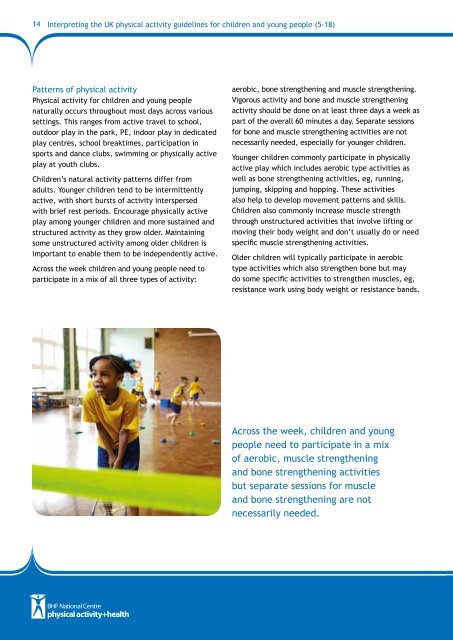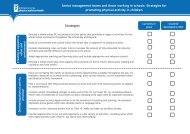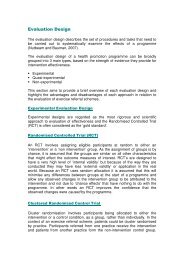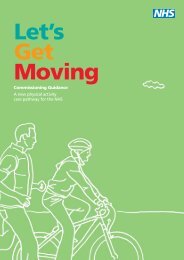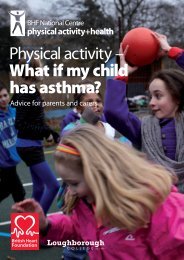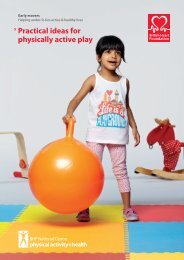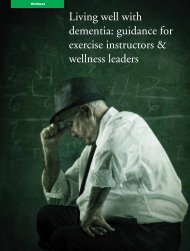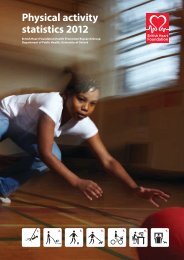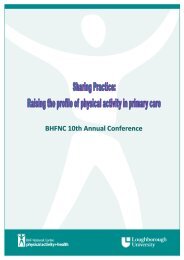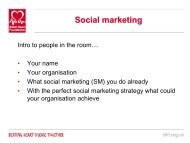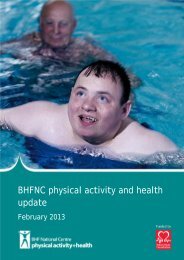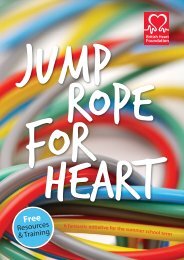Interpreting the UK physical activity guidelines for children and ...
Interpreting the UK physical activity guidelines for children and ...
Interpreting the UK physical activity guidelines for children and ...
Create successful ePaper yourself
Turn your PDF publications into a flip-book with our unique Google optimized e-Paper software.
14<br />
<strong>Interpreting</strong> <strong>the</strong> <strong>UK</strong> <strong>physical</strong> <strong>activity</strong> <strong>guidelines</strong> <strong>for</strong> <strong>children</strong> <strong>and</strong> young people (5-18)<br />
Patterns of <strong>physical</strong> <strong>activity</strong><br />
Physical <strong>activity</strong> <strong>for</strong> <strong>children</strong> <strong>and</strong> young people<br />
naturally occurs throughout most days across various<br />
settings. This ranges from active travel to school,<br />
outdoor play in <strong>the</strong> park, PE, indoor play in dedicated<br />
play centres, school breaktimes, participation in<br />
sports <strong>and</strong> dance clubs, swimming or <strong>physical</strong>ly active<br />
play at youth clubs.<br />
Children’s natural <strong>activity</strong> patterns differ from<br />
adults. Younger <strong>children</strong> tend to be intermittently<br />
active, with short bursts of <strong>activity</strong> interspersed<br />
with brief rest periods. Encourage <strong>physical</strong>ly active<br />
play among younger <strong>children</strong> <strong>and</strong> more sustained <strong>and</strong><br />
structured <strong>activity</strong> as <strong>the</strong>y grow older. Maintaining<br />
some unstructured <strong>activity</strong> among older <strong>children</strong> is<br />
important to enable <strong>the</strong>m to be independently active.<br />
Across <strong>the</strong> week <strong>children</strong> <strong>and</strong> young people need to<br />
participate in a mix of all three types of <strong>activity</strong>:<br />
aerobic, bone streng<strong>the</strong>ning <strong>and</strong> muscle streng<strong>the</strong>ning.<br />
Vigorous <strong>activity</strong> <strong>and</strong> bone <strong>and</strong> muscle streng<strong>the</strong>ning<br />
<strong>activity</strong> should be done on at least three days a week as<br />
part of <strong>the</strong> overall 60 minutes a day. Separate sessions<br />
<strong>for</strong> bone <strong>and</strong> muscle streng<strong>the</strong>ning activities are not<br />
necessarily needed, especially <strong>for</strong> younger <strong>children</strong>.<br />
Younger <strong>children</strong> commonly participate in <strong>physical</strong>ly<br />
active play which includes aerobic type activities as<br />
well as bone streng<strong>the</strong>ning activities, eg, running,<br />
jumping, skipping <strong>and</strong> hopping. These activities<br />
also help to develop movement patterns <strong>and</strong> skills.<br />
Children also commonly increase muscle strength<br />
through unstructured activities that involve lifting or<br />
moving <strong>the</strong>ir body weight <strong>and</strong> don’t usually do or need<br />
specific muscle streng<strong>the</strong>ning activities.<br />
Older <strong>children</strong> will typically participate in aerobic<br />
type activities which also streng<strong>the</strong>n bone but may<br />
do some specific activities to streng<strong>the</strong>n muscles, eg,<br />
resistance work using body weight or resistance b<strong>and</strong>s.<br />
Across <strong>the</strong> week, <strong>children</strong> <strong>and</strong> young<br />
people need to participate in a mix<br />
of aerobic, muscle streng<strong>the</strong>ning<br />
<strong>and</strong> bone streng<strong>the</strong>ning activities<br />
but separate sessions <strong>for</strong> muscle<br />
<strong>and</strong> bone streng<strong>the</strong>ning are not<br />
necessarily needed.


